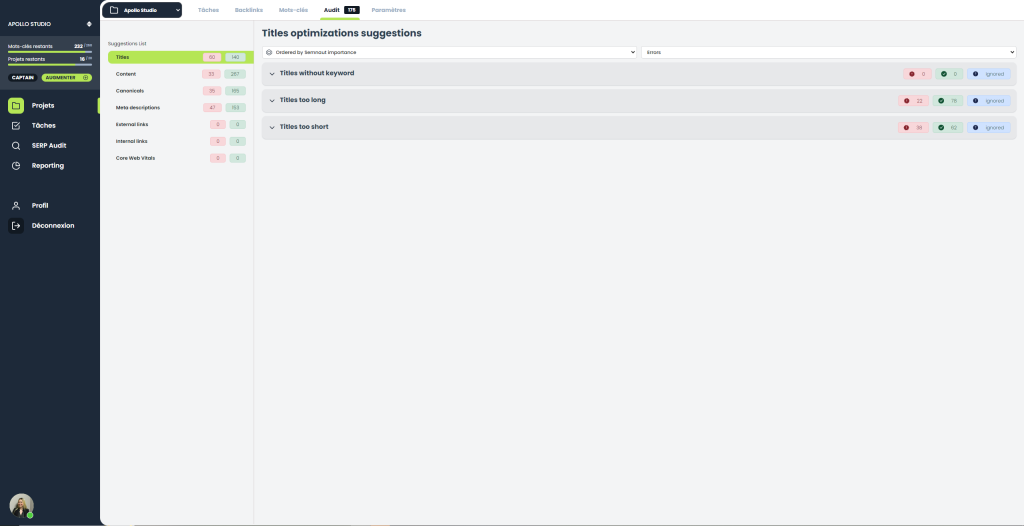The impact of backlinks on SEO
Do you want to improve your SEO and search engine visibility? Then you can’t do without backlinks. These famous inbound links are one of the most influential factors in your search engine rankings. But how exactly do they work? And how do you get quality backlinks? Let’s discover the importance of backlinks in SEO.
Leave nothing to chance! With Semnaut’s SEO alerting and suggestions, stay up to date with SEO developments and maximize the impact of your sites.

What is a backlink?
A backlink, also known as an inbound link, is a link on a third-party website that points to one of your web pages. Every time another site gives you this “vote of confidence” by citing you as a source, you gain a valuable backlink.

The evolution of backlinks over time
Originally, search engines like Google relied primarily on anchor text (the words clicked to follow the link) and the number of backlinks to determine a page’s relevance and ranking.
But in the face of numerous cheating attempts, algorithms quickly evolved. Nowadays, it’s the quality and semantic relevance of incoming links that take precedence. A backlink is only of value if it comes from a trusted website and fits naturally into quality content.
Why are backlinks crucial to your SEO?
Search engine optimization (SEO) is a balancing act, where many factors come into play to determine your positioning in the search results. Among them, backlinks play a key role. More than just a criterion, they represent the keystone of any successful SEO strategy. But why are they so decisive?
Backlinks and domain authority
In SEO, the reputation and authority of your website are essential to your ranking. The more reputable and reliable your domain is in the eyes of the search engines, the better your pages will rank.
And backlinks are a powerful signal of authority. Each incoming link counts as a recommendation, a mark of trust granted by another site. The more relevant and quality backlinks you accumulate, the higher your domain authority will climb.
Backlinks: beyond SEO, the impact on referral traffic
Backlinks are essential for your SEO ranking. But their benefits don’t stop there! Backlinks also bring you valuable referral traffic.
Every time someone clicks on a link to your site, they land directly on your pages. A good backlink profile enables you to attract qualified visitors interested in your content or services.
Innovative strategies for acquiring backlinks
Now that we’ve grasped the crucial importance of backlinks for SEO, the question is: how do you get quality ones? While natural links remain the ideal choice, there are many techniques available today for actively stimulating backlink acquisition. Creative and innovative strategies are developed every year to boost your backlink profile.
Creative link building tactics
The best way to generate natural, high-quality backlinks is to produce outstanding content. In-depth studies, practical guides, in-depth analyses… this type of high value-added content has every chance of generating spontaneous links.
You can also develop more creative netlinking strategies such as :
Content marketing on influential blogs in your sector
Creating free resources or tools with high viral potential
Developing public relations with complementary sites
Using social networks to generate backlinks
Social networks also represent a formidable lever for acquiring natural backlinks. By regularly sharing quality content, you increase your chances of being relayed and cited as a source by other sites.
In addition, platforms such as YouTube, Slideshare and Wikipedia are excellent sources of backlinks to cultivate. Creating content tailored to these channels can therefore be very beneficial to your link profile.
Analyze and measure the impact of backlinks
Acquiring quality backlinks alone is not enough to succeed in SEO. You also need to be able to monitor, analyze and optimize your netlinking strategy on an ongoing basis. This is the key to maximizing the impact of your backlinks on your SEO.
To effectively manage your backlink profile, you need the right tools and the right metrics. This will enable you to identify the strengths and weaknesses of your strategy, and then adjust your course of action.
Add, track and optimize your SEO projects faster than ever. Make Semnaut the heart of your SEO strategy for seamless collaboration and management.
.
Key tools and metrics
To effectively manage your netlinking strategy, it’s essential to carefully analyze your backlink profile. There are several tools you can use to track and measure the impact of your inbound links, such as :
Google Search Console (to identify referring sites)
Ahrefs, Semrush (to analyze backlink quality)
Majestic (to calculate your domain authority)
Ubersuggest (to find backlink opportunities)

The main metrics to monitor are the number of backlinks, their authority (domain authority score), their age, their semantic relevance and the variety of referring domains.
Risks and pitfalls to avoid in a backlinking strategy
Implementing a paid netlinking strategy is not without risk. If it isn’t carefully thought out and executed, it can quickly become counterproductive, or even detrimental to your SEO. In addition to the importance of targeting quality backlinks, you also need to guard against certain common pitfalls.
Identifying toxic backlinks
Not all backlinks are good for you! Some inbound links can even be toxic, harming your SEO.
These include links from unsafe sites (scams, spam, etc.), link farms or networks of satellite sites created for the sole purpose of artificially inflating backlinks.
To avoid penalties, it’s crucial to regularly audit your link profile and remove any dubious or low-quality backlinks.
How to recover from a backlink penalty?
If your site has already been penalized by Google for backlink practices considered to be spam, don’t panic! There are ways to get back on track.
The first step is to identify and remove all bad inbound links via Google’s now famous Disavow Tool. Then focus on acquiring high-quality, natural backlinks to regain the trust of the search engines.
The future of backlinks in SEO
Emerging trends
The backlink landscape continues to evolve as search algorithms are updated. Emerging trends include :
the growing importance of branded backlinks (with the brand name in the anchor text)
Increased consideration of actual referral traffic generated by links
Particular attention to links from social networks
A focus on the freshness and speed of backlink acquisition
Prepare your backlink strategy for the future
To remain competitive in this race for the best natural referencing, it will be essential to constantly adapt. Here are a few tips to help you prepare your strategy now:
- Diversify your backlinks as much as possible (guest posts, resources, social links, etc.).
- Focus on the semantic authority of your pages to attract relevant links.
- Focus on the quality of your backlinks, rather than quantity.
- Keep a close eye on evolving algorithms and new requirements
Backlinks: a long-term investment
Building an effective and sustainable backlink strategy takes time, continuous effort and a long-term vision. Of course, acquiring quality inbound links requires patience and hard work. But it’s an investment that, if well managed, will pay off for years to come.
Rather than seeking quick, short-lived results through risky tactics, focus on the regular production of valuable content. By establishing yourself as a key reference in your field, you’ll naturally attract backlinks and qualified traffic.
Be proactive too, by building long-term relationships with partner sites. These authentic connections will bring you genuine referrals, far more valuable than artificially acquired links.
Finally, remember that search engine trust is earned over time. Play the quality card rather than the quantity card, and remain constant in your efforts. If your backlink strategy is sound and consistent, the results will eventually pay off.

